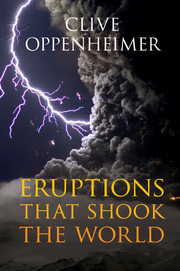Book contents
- Frontmatter
- Contents
- Preface
- Acknowledgements
- 1 Fire and brimstone: how volcanoes work
- 2 Eruption styles, hazards and ecosystem impacts
- 3 Volcanoes and global climate change
- 4 Forensic volcanology
- 5 Relics, myths and chronicles
- 6 Killer plumes
- 7 Human origins
- 8 The ash giant/sulphur dwarf
- 9 European volcanism in prehistory
- 10 The rise of Teotihuacán
- 11 Dark Ages: dark nature?
- 12 The haze famine
- 13 The last great subsistence crisis in the Western world
- 14 Volcanic catastrophe risk
- Appendix A Large eruptions
- Appendix B Further reading and data sources
- References
- Index
8 - The ash giant/sulphur dwarf
Published online by Cambridge University Press: 01 June 2011
- Frontmatter
- Contents
- Preface
- Acknowledgements
- 1 Fire and brimstone: how volcanoes work
- 2 Eruption styles, hazards and ecosystem impacts
- 3 Volcanoes and global climate change
- 4 Forensic volcanology
- 5 Relics, myths and chronicles
- 6 Killer plumes
- 7 Human origins
- 8 The ash giant/sulphur dwarf
- 9 European volcanism in prehistory
- 10 The rise of Teotihuacán
- 11 Dark Ages: dark nature?
- 12 The haze famine
- 13 The last great subsistence crisis in the Western world
- 14 Volcanic catastrophe risk
- Appendix A Large eruptions
- Appendix B Further reading and data sources
- References
- Index
Summary
When the modern African human diaspora passed through the prism of Toba's volcanic winter, a rainbow of differences appeared.
S. H. Ambrose, Journal of Human Evolution (1998) [124]The eruption of the Younger Toba Tuff in northern Sumatra 73,000 years ago expelled seven thousand billion tonnes of silicic magma (Me 8.8) and, by some estimates, as much as three gigatonnes of sulphur (more than 300 times as much as Pinatubo's 1991 eruption). It made a sizeable contribution to a 100-kilometre-long by 30-kilometre-wide hole in the ground that is today occupied by Lake Toba. This enormous magnitude ranks Toba as one of the largest single eruptions ever documented, along with the 27.8-million-year-old Fish Canyon Tuff associated with La Garita caldera in the San Juan Mountains of Colorado (Me 9.1–9.2) and the two-million-year-old Huckleberry Ridge Tuff of Yellowstone (Me 8.7–8.9). The much more recent Younger Toba Tuff eruption took place close to the time Middle Stone Age Homo sapiens left Africa prompting far-reaching debate concerning the impacts and consequences for modern human adaptation, cognition and migration. Using geological and modelling evidence, this chapter reconstructs the cataclysmic events, and scrutinises the evidence for Toba's impact on the environment, climate and our human ancestors.
THE ERUPTION
Today, the Toba region is a place of rugged peaks, lush forests and bamboo groves, and emerald rice terraces enclosing the traditional villages of the Batak people. And then there are the inviting blue waters of Lake Toba itself.
- Type
- Chapter
- Information
- Eruptions that Shook the World , pp. 181 - 207Publisher: Cambridge University PressPrint publication year: 2011



